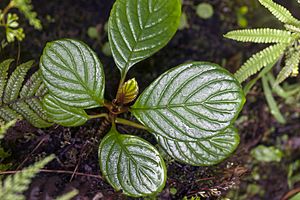Cyrtandra heinrichii facts for kids
Quick facts for kids Cyrtandra heinrichii |
|
|---|---|
 |
|
| Conservation status | |
| Scientific classification | |
| Genus: |
Cyrtandra
|
| Species: |
heinrichii
|
Cyrtandra heinrichii, also called ha'iwale or lava cyrtandra, is a beautiful flowering plant. It grows year after year, which means it's a perennial plant. This plant belongs to the Gesneriaceae family. You can only find it on the Hawaiian island of Kauai.
What is Lava Cyrtandra Like?
The lava cyrtandra is a type of shrub. It often grows near waterfalls, clinging to rocky walls made of basalt. You can also find it in shrubland areas. It likes wet, warm forests where Metrosideros trees are common. This plant often grows alongside ferns. It lives in places that are between 730 and 1,350 meters (about 2,400 to 4,400 feet) high. Cyrtandra heinrichii is closely related to another plant called Cyrtandra wawrae.
Why is Lava Cyrtandra in Danger?
The lava cyrtandra is an endangered species. This means it is at a high risk of disappearing forever. Experts believe there are only about 250 to 1,000 adult plants left. These plants are spread out in 9 small groups. The total area where they live is only about 10 square kilometers (about 4 square miles). Some of these plants live in a special protected area called a Natural Area Reserve.
What Harms the Plants?
Several things threaten the lava cyrtandra:
- Animals: Slugs and rodents can damage the plants. Wild pigs also cause problems by destroying the places where the plants grow.
- Invasive Plants: Other plants that are not native to Hawaii are a big threat. These "invasive" plants grow very fast and take up space, water, and sunlight that the lava cyrtandra needs. Some of these harmful plants include:
- Erigeron karvinskianus
- Hedychium gardnerianum
- Clidemia hirta
- Cyathea cooperi
- Andropogon virginicus
- Rubus rosifolius
- Blechnum appendiculatum
- Pterolepis glomerata
- Erechtites valerianifolius
- Less Pollination: Native birds and insects help pollinate the lava cyrtandra. This means they help the plants make seeds to grow new plants. But the number of these helpful birds and insects is going down. This makes it harder for the lava cyrtandra to reproduce.


